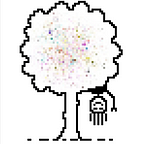🌳📖💻#2:💥🌼🌸 — BlossomBuilder
Check out the thing, look at the code, and read about it if you’re interested:
I sat down this morning and drew some crazy papers with boxes and arrows to figure out what does a Crash Blossom consist of at an abstract level.
Of course, there are more possibilities. 😜
I found one that I felt I could implement at my current level of knowledge:
¿Why?
Currently I’m wondering about my flashcard generation and whether I am making them with too little connection to what I’m practically learning. So when my morning-revisit brought me face-to-face with one card asking me for an example of a Crash Blossom, I thought I’d take my answer a step further. — Also, I learn well with doing projects!
Check it out live on AWS— or see the code and run it locally!
Whazzitdo?
It creates ambiguous pseudo-headlines (in Title Case).
Howsitdodat?
It uses some fun ambiguities that exist in natural languages — specifically one that is pervasive in English:
Ambiguity based on words that can be both nouns and verbs
English is a weakly inflected language, meaning that generally words don’t change according to their grammatical position. A lot of meaning is done with word order instead. Other languages change their verbs and nouns to expressing grammatical concepts, making such type of ambiguity less likely to occur.
Reading this article and doing some crazy drawings brought me to the conclusion that I’ll try to make Crash Blossoms based on the following:
- focusing on noun-verb ambiguity
- additionally utilizing that both plural nouns and verbs in 3rd person singular end with an -s
- putting two pairs of (potential) composite nouns next to each other
- where the two middle ones should be noun-verb-ambiguous
That allows the reader to flip-flop between two possible interpretations, which is essentially the basic fun of all that.
Of course there’s much more to the humor of Crash Blossoms, and this one-day-hack for learning purposes doesn’t catch a lot of it.
But, if you’re lucky and enter the right words, you can get sentences such as:
Gator Attacks Puzzle Experts
Which is claimed to actually be a real headline, and I think it’s super fun! (at least if you’re not a puzzle expert) 😱 🐊
Showyasteps!
- I checked out a few Crash Blossoms to look for some generalized pattern I’d be able to re-create.
- I read a bit and drew a bit.
- Then I distilled these half-actionable rules:
* Capitalize words to increase possible ambiguity
* Use nouns that pluralize with -s
* The inner two need to be noun-verb ambiguous
* The noun-verb part of the composite noun needs to end with -s - I wrote some code that takes word input and sticks it onto the page
- Only when I saw that all this could work, I went to scrape for Noun-Verbs and used BeautifulSoup to get a list of Noun-Verbs from the net
- Then I puzzled it together
(Constantly looking over my shoulder for that 🐊 !) - And finally did some mini prettification and put it up on Github
Let me know what you think and if you like it, and definitely talk to me about ways to improve it!
It’s nothing special now and not even that much fun, because there’s a lot more to humor than just random words — even if they fulfill a certain criteria.
- I am aware that utilizing Collocation information could make it way more interesting, and maybe I come back to it once I know how to do that.
- A friend also suggested to only use nice words, so maybe another revisit could come after learning more about Sentiment Analysis.
I’m always open for suggestions, and if you happen to generate one that is actually fun, you can post it in a comment down here : )
